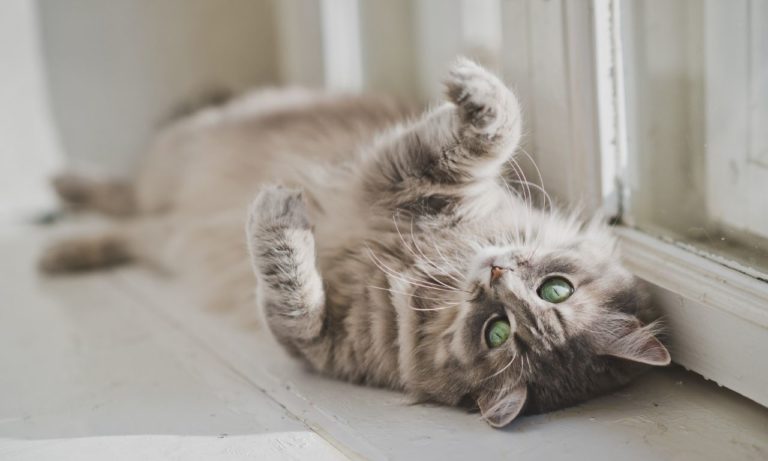Why Do Cats Pee On Bathroom Rugs? (Solutions)
Most cats are very clean creatures and will use their litter box religiously. However, there are some kitties who have issues with using the litter box and will instead relieve themselves on things like bathroom rugs.
While this behavior may be frustrating for cat owners, it’s important to remember that there’s usually a reason behind it.
In many cases, cats will urinate on rugs as a way of marking their territory. If a cat feels like their territory is being threatened, they may start urinating on things in an attempt to reclaim their space.
There are also number of reasons why cats may develop a preference for urinating in one particular spot, including stress, anxiety, or illness.
So, here I’ll cover some of the different causes behind your cat’s bathroom rug peeing and offer some tips on how you can address these issues and help keep your kitty from marking their territory in an unhealthy way.
5 Possible Reasons Why Do Cats Pee on Bathroom Rugs

If you’ve noticed that your cat is regularly urinating on your bathroom rugs, there could be several different reasons behind this behavior.
1. Territorial Marking

Cats sometimes exhibit behaviors that seem inexplicable or even downright strange to us. One such behavior is territorial marking, which involves urinating on objects or areas inside the home.
While there can be many reasons for this behavior, one of the most common explanations is that cats are marking their territory in order to assert dominance and protect their spaces from other animals. This behavior can be frustrating for cat owners, and it may require the help of a veterinarian in order to correct.
From my experience I found this type of behavior mostly observed in male unneutered cats but females might also do it. Again some kitty peeing in odd places such as rugs and mats can become habit forming.
2. Stress or Anxiety

When a cat pees on a bathroom rug, there are likely several factors contributing to this behavior. Some possible causes include stress or anxiety, as well as medical issues.
According to veterinarians, one common cause of feline urination is stress or anxiety. In particular, cats may be reacting to changes in their environment such as new people, pets, or even furniture that has been added to the home.
Additionally, some cats may experience anxiety when left alone for long periods of time, especially if they are not acclimated to spending time alone.
3. Physical Issues

In some cases, feline urination can be the result of a physical issue. Urinary tract infections and other medical conditions are often associated with urinary marking, so it’s important to get your cat the medical attention they need.
According to Dr. Marci Koski, a veterinarian and feline behavior specialist at the University of Tennessee College of Veterinary Medicine, some common physical causes of cat urination include diabetes, kidney disease, and other diseases of the urinary tract.
In order to address this issue, it’s important to take your cat to their veterinarian for a full examination. From there, they will be able to determine the cause of your cat’s bathroom rug peeing and advise you on the best course of treatment.
4. Litter Box Problems

There are also a number of litter box issues that may be contributing to your cat’s bathroom rug peeing. Some common causes include using the wrong type of litter, not cleaning the litter box often enough, or providing an inadequate number of boxes per cat.
Wrong type litter box
A cat is a very clean animal, and as such requires a clean, appropriate place to urinate and defecate. A wrong type litter box for cats can be anything from an unsanitary container or tray to one that is too small or does not offer the necessary privacy and comfort for the cat.
Poor hygiene in the box can lead to health problems for the cat, including infections of the urinary tract and bladder. To avoid these issues, it is important to make sure that you are providing your cat with a safe and comfortable space where they can do their business.
This may include purchasing an appropriate litter box or changing out old litter regularly. Additionally, it is important to keep your cat’s area clean by scooping out any waste on a regular basis and washing out the box at least once per month.
With proper care and attention, you can help ensure that your cat has all of the tools they need to live a happy, healthy life.
Not cleaning the litter box often enough

Cats are known for being clean and particular about their living environments, so it can be troubling when a cat owner does not clean their litter box often enough.
Not cleaning the litter box often enough can lead to your cats having difficulties urinating, which in turn can cause them to start peeing on bathroom rugs around the house.
This is a problem that needs to be addressed quickly in order to avoid further damage and unpleasant odors. To avoid this issue, it is important to regularly clean your cat’s litter box using safe and effective cleaning products.
Some common options include enzymatic cleaners that break down urine stains and odors, as well as baking soda or vinegar solutions that neutralize any lingering smells in the box.
Additionally, it is important to scoop out any clumps or waste from the box on a regular basis, especially if you have multiple cats using the same litter box.
If you are struggling with cats urinating on bathroom rugs or other areas of your home due to an unclean litter box, it is important to take action quickly by addressing any underlying issues with your cats’ toileting habits.
With careful attention and consistent cleaning practices, you can help keep your cats healthy and comfortable in their environment while also preventing unwanted messes around the house.
Inadequate number of boxes per cat
Cats often urinate on bathroom rugs as a result of having an inadequate number of boxes per cat in their environment. This can be due to any number of factors, including a lack of space in the home, too few litter boxes, or an issue with the quality or placement of these boxes.
If you notice that your cat is frequently urinating on your bathroom rugs, it is important to take steps to address this behavior as soon as possible.
You may need to add more litter boxes to your home, or try switching up the type and placement of these boxes in order to encourage your cat to start using them instead of your bathroom rugs.
Additionally, consulting with a veterinarian can help you understand if there might be any underlying health concerns contributing to your cat’s behavior, and can help you develop an effective plan for helping them address these issues.
With time and patience, you can work with your cat to help them overcome their tendency to pee on bathroom rugs by addressing the underlying cause and providing effective behavioral reinforcement strategies.
5. Your Cats Probably Likes The Rug

Cats are instinctively drawn to the soft, warm feel of bathroom rugs, making them a perfect target for peeing and spraying. This behavior is thought to be linked to territorial marking, as cats use their urine to leave behind pheromones that signal their presence and help them establish dominance over other cats in the area.
In addition to this instinctual drive, cats may also prefer bathroom rugs because of the close proximity to their litter boxes. These rugs provide a warm surface for eliminating waste, which may be more comfortable or preferable than other surfaces in the home.
Once a cat peeing on bathroom rugs has become established behavior, it can be difficult to break. No matter how well you clean or how often you replace your bathroom rugs, there is a good chance that your cat will continue to return to this surface for toileting.
How to Stop a Cat from Peeing on Rugs?
If your cat is peeing on rugs around the house, there are steps you can take to try and break this destructive behavior. Here I’ll share some tips and recommendations for keeping your cat away from rugs and other areas of your home:
1. Consult With a Veterinarian

When it comes to cats peeing on the bathroom rugs, one of the most important things to consider is consulting with a veterinarian.
A veterinarian can provide a variety of helpful insights and recommendations that can help you address this issue and get your cat back on track. One of the first things that a veterinarian will typically do is conduct a full medical examination of your cat, looking for any underlying conditions or health issues that may be causing them to urinate outside of their litter box.
This may involve blood tests, urine tests, or other diagnostic measures to get a better understanding of what is going on with your pet. In addition to diagnosing any underlying health problems, your veterinarian can also provide valuable advice and guidance on how to address this behavior.
For example, they may recommend using different types of litter or litter boxes, providing more frequent cleaning and maintenance of litter boxes, and utilizing additional strategies like positive reinforcement training to encourage good litter box habits.
So if you are struggling with cats peeing on the bathroom rugs in your home, it is important to reach out for professional help from a trusted veterinarian who can assess the situation and offer effective solutions for resolving this issue.
2. Use Litter Mats and Rugs

When it comes to preventing cats from urinating on your bathroom rugs, one of the most important things to consider is the use of litter mats and rugs.
These are designed specifically to help keep your cats away from your bathroom flooring, while also providing a comfortable surface for them to lay on. To start using a litter mat or rug in your bathroom, you will first need to choose a suitable mat that is large enough to cover the area where your cat typically likes to urinate.
You should then place this mat in front of or directly next to any areas that are prone to urine stains or odors, such as near the toilet, sink, or bathtub. Once your mat is placed, you can then start working with your cat to encourage them to use it instead of their usual spots.
This may involve simply petting and praising them whenever they go near the mat, or placing some treats nearby that they can reach once they step onto it. Over time, your cat should begin associating the mat with positive reinforcement, which can help reduce their desire to urinate elsewhere in the bathroom.
Another useful tip for preventing cats from peeing on bathroom rugs is to regularly clean and maintain your mats and rugs by vacuuming or shaking out any loose dirt on a regular basis. This will help keep them free from bacteria and other harmful substances that could encourage your cat’s interest in peeing on the rug again.
3. Use Pheromone Sprays

When dealing with cats who have developed a habit of urinating on your bathroom rugs, it can be helpful to utilize pheromone sprays as a way to prevent them from doing so. These sprays contain chemicals that mimic the pheromones that cats naturally produce when they are marking their territory.
To use these sprays effectively, start by identifying the areas where your cat is most likely to urinate. These may include around doorways and entryways, along baseboards, or in other spots where they feel safe and secure. Once you have identified these areas, apply the pheromone spray directly onto them.
You can also try spraying some of this pheromone-containing solution into your cat’s litter box in order to help encourage them to use it more frequently.
Additionally, you can also try sprinkling some of the solution onto their regular scratching posts or other areas where they are likely to leave scent markers, such as high-traffic areas in your home.
Overall, using pheromone sprays is an effective way to discourage your cat from peeing on your bathroom rugs or other surfaces in your home.
By pinpointing the areas where your cat feels most comfortable urinating and applying the appropriate spray directly to these areas, you can reduce unwanted urine marking behaviors and keep your home clean and free from unpleasant odors.
4. Upgrade Your Litter Box

When you are looking to upgrade your litter box to help prevent your cats from peeing on the bathroom rugs, there are a few key things that you will want to consider.
First, it is important to focus on the size of your litter box, as this will play a major role in whether or not your cats are able to comfortably use it. You may also want to look for a litter box with high sides or an enclosed design, as these can help keep urine and odors contained and prevent them from seeping onto your rugs.
In addition to choosing the right type of litter box, it is also important to pay attention to the type of materials used in its construction.
Many experts recommend opting for a plastic or stainless steel litter box, as these materials can be more durable and less prone to leaking than other options.
Furthermore, you may want to consider adding some additional features like a mat or liner inside the box, which can further help prevent leaks and keep your bathroom rugs clean and stain-free.
If you are looking for a simple and effective way to upgrade your litter box and discourage your cats from peeing on the bathroom rugs, then focusing on these key factors is essential.
By choosing the right type of litter box that is designed for durability and ease of use, as well as adding some additional features like a mat or liner inside the box, you should be able to effectively protect your rugs from unwanted stains and unpleasant odors caused by cat urine.
5. Block Access to the Rugs

Cats are naturally curious creatures and can often be found exploring new and unfamiliar spaces. They may also be attracted to areas that they consider to be their territory, such as the bathroom rugs in your home.
If you have a cat that is prone to urinating on the bathroom rugs, there are some steps you can take to prevent them from accessing this space and help keep your rugs clean and urine-free.
One of the most important things you can do is to simply block access to the bathroom rugs. This can be done by placing a sturdy barrier or cover over the top of them, such as a piece of furniture or heavy curtains.
Alternatively, you may wish to try out some deterrents that are specifically designed for cats, such as citrus sprays or scented oils.
If possible, it is also a good idea to keep other spaces in your home that your cat may see as its territory off-limits to them while they are still learning not to urinate on the bathroom rugs.
This can include limiting their access to other rooms in your house and making sure that all doors and windows are closed at all times.
Ultimately, with a little patience and dedication, it is possible to successfully train your cat not to pee on the bathroom rugs by blocking access and using appropriate deterrents.
With consistent positive reinforcement and a commitment on your part, you should be able to effectively discourage this behavior in no time at all.
6. Use Positive Reinforcement
When it comes to preventing your cats from peeing on the bathroom rugs, one of the most effective strategies is to use positive reinforcement. This involves rewarding your cats when they use the litter box instead of the rugs, as a way to encourage them to continue behaving in this way in the future.
To start, you will need some treats or toys that your cats find particularly appealing. Once your cats begin using the litter box instead of the rugs, immediately reward them with one of these treats or toys as a sign of their good behavior.
Repeat this process each time they use the litter box so that they quickly learn that this is an acceptable behavior and something that gets rewarded by you.
In addition to providing rewards for appropriate behaviors, another useful strategy is to try and avoid giving your cats any attention or encouragement if they are doing things like scratching or marking on the rugs.
For instance, if you see them starting to scratch at or pee on a rug, you can try gently distracting them by redirecting their attention elsewhere in the room or making a noise like clapping your hands. Over time, this can help discourage them from continuing these behaviors and reinforce their desire to use their litter box instead.
Ultimately, by incorporating positive reinforcement into your cat’s training routine and discouraging inappropriate behaviors such as peeing on bathroom rugs, you can help prevent these issues from occurring and ensure that both you and your cats enjoy a happier and more peaceful home environment.
My Final Thoughts
I’ve said it before and I’ll say it again: there is no one reason why cats pee on bathroom rugs. In my experience, it’s usually a combination of stress, anxiety, and frustration. Cats are creatures of habit, and any change in their environment can be stressful.
Whether it’s a new baby in the house, a move to a new home, or even just a change in the furniture layout, anything that disrupts their routine can cause stress. And when cats are stressed, they often express that stress by peeing outside the litter box.
Bathroom rugs provide an easy target because they’re usually soft and absorbent. Additionally, the bathroom is often a place where cats feel anxious or frustrated. They may associate the sound of the toilet flushing with the loud noise of a vacuum cleaner, for example.
As a result, they may start to avoid using the litter box when they hear those sounds. Ultimately, there is no single answer to the question of why cats pee on bathroom rugs.
It’s important to remember that every cat is different, and what works for one cat may not work for another. If your cat is urinating outside the litter box, it’s important to talk to your veterinarian or a qualified animal behaviorist to find out what’s causing the problem and how best to solve it.






